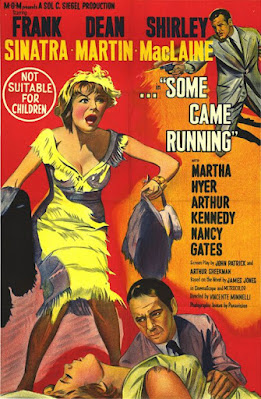In 1951, World War II veteran
James Jones published a blockbuster novel about the lives and loves of American
troops stationed in Honolulu at the time of the attack on Pearl Harbor. When From
Here to Eternity became a film two years later, it took Hollywood by storm.
Its 13 Oscar nominations resulted in eight wins, including Best Picture, Best
Director, and a statuette for Frank Sinatra, bringing his own bitterness and
pugnacious spirit to the role of Maggio, as the year’s Best Supporting Actor.
It seemed the combination of James Jones’ writing and Sinatra’s acting chops was a potent one. That’s why, when in 1957 Jones published a second novel—this time dealing with a returning soldier during the post-war period—Hollywood again came calling, ready to star Sinatra as a tough-but-tender protagonist in another James Jones adaptation. But Jones’ new novel, Some Came Running, had a few problems. The New Yorker’s critic colorfully called it “twelve hundred and sixty-six pages of flawlessly sustained tedium.”
This was the shoot on which Sinatra, always an impatient actor, apparently ripped twenty pages out of the script in order to keep the film’s length close to the two-hour mark. Director Vincente Minnelli, looking for a change of pace from his own sparkling Gigi (also from 1958), had the challenge of corralling Sinatra and co-star Dean Martin, while also staying true to his own artistic vision. It culminated in a brilliantly florid climax, set at night amid the gaudy neon lights of a small-town carnival. The film earned five Oscar noms, mostly in acting categories, but not a single win. (Gigi and the actors from Separate Tables were the year’s big awards recipients.)
I’ve heard film scholars praise the aesthetics of Some Came Running, as well as Minnelli’s blunt treatment of the hypocrisies of Midwest life. And I can’t deny that there are some strong performances, notably that of Shirley MacLaine (nominated for her first Oscar for this, her all-time favorite role). She plays Ginny, a slightly tawdry but good-hearted waif whose love for Dave leads at last to tragedy. (The film’s tweak of the novel’s original ending definitely increases its poignance.) There’s also good work by Sinatra and by his pal, Dean Martin, as a hard-drinking gambler who’s lovable but on a path to self-destruction.
All this should make it clear that the film’s plot is an intensely melodramatic one, with far too many characters and lots of lurid small-town misbehavior. When Sinatra’s character, in military uniform, gets off the bus in his old hometown, it’s clear he’s a bit disgusted by the locals, but even more unimpressed with himself. Though he’s published several novels and has something of a literary reputation (like, of course, James Jones), he seems unable to move forward with his writing career. He’s also got a serious grudge against the well-heeled brother (Arthur Kennedy) who’s now one of the town’s leading citizens but chafes at his wife’s snootiness, to the point where he strays with an attractive employee.
Oddly, it’s through his brother that Sinatra’s Dave comes to know a local professor and his schoolmarm-daughter, both of whom highly respect him as a man of letters. We’re supposed to believe that the prim schoolteacher (Martha Hyer) is Dave’s true love, though—aside from a rare moment when he literally takes her hair down—she seems incapable of passion of any sort. Her scenes with Sinatra come across as stodgy, as she lectures him on literature and life. Under the circumstances, a gauche, umgrammatical Ginny would seem like an improvement, especially given MacLaine’s wistful charm.


No comments:
Post a Comment